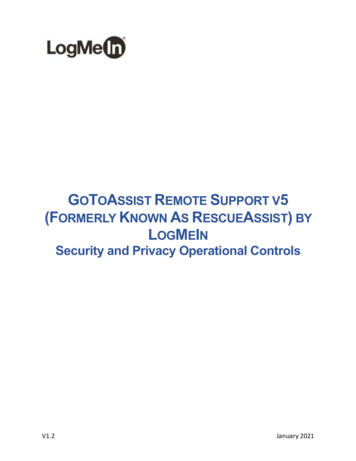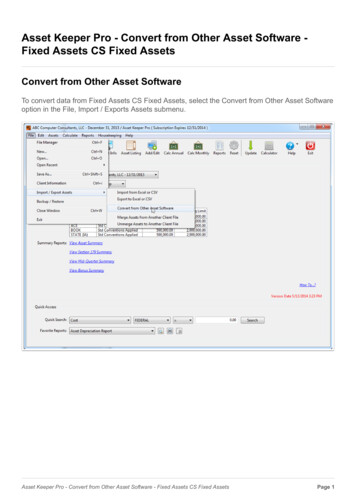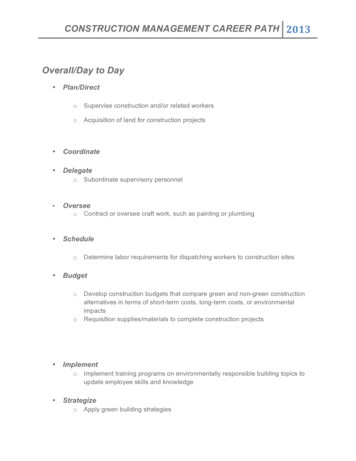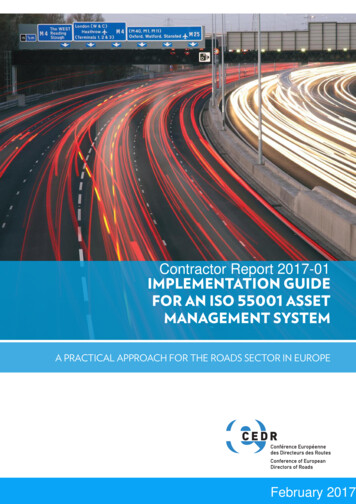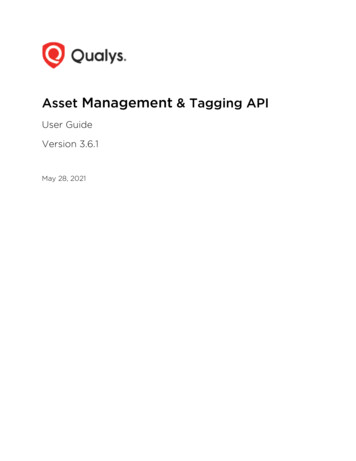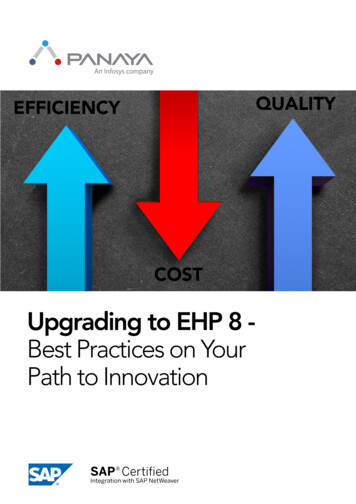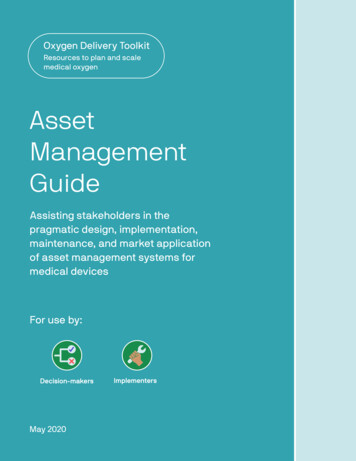
Transcription
Oxygen Delivery ToolkitResources to plan and scalemedical oxygenAssetManagementGuideAssisting stakeholders in thepragmatic design, implementation,maintenance, and market applicationof asset management systems formedical devicesFor use by:Decision-makersMay 2020Implementers
This resource is part of the Oxygen Delivery Toolkit: Resources to plan and scale medical oxygen. Thematerials provided within the toolkit can be used together or separately, as needed. The completeOxygen Delivery Toolkit includes the following resources: Oxygen is Essential: A Policy and Advocacy Primer Health Facility Standards Guide Baseline Assessment Manual Consumption Tracking Tool Procurement Guide Quantification and Costing Tools Reference Pricing Guide Electricity Planning Guide Asset Management GuideThe toolkit is available at tsThe Oxygen Delivery Toolkit: Resources to plan and scale medical oxygen was developed by PATH, in collaborationwith international and national maternal, newborn, and child health and industry partners, as well asthe ministries of health in India, Indonesia, Kenya, Malawi, and Senegal. The authors are grateful to eachcontributor for their insightful feedback and support on the development of the toolkit components.Oxygen Delivery Toolkit disclaimerThe Oxygen Delivery Toolkit (the “Toolkit”) is a compilation of guides and tools developed by PATH with funding from the Bill & Melinda GatesFoundation to assist decision-makers, implementers, and advocates in scaling up access to medical oxygen. The Toolkit is for informational,noncommercial use only and users of the Toolkit are prohibited from selling, renting, or leasing the Toolkit or from creating derivative works(other than outputs and results derived from use of the Toolkit) or improvements to the Toolkit. The accuracy, completeness, adequacy, orcurrency of the Toolkit is not warranted or guaranteed. The results of this Toolkit depend on the assumptions and values considered byusers, and users of the Toolkit alone are responsible for the results generated by the Toolkit. Users agree not to use or rely on the Toolkit as asubstitute for or to the exclusion of consultation with independent professionals and experts. Use of the Toolkit is at the user’s own risk. THETOOLKIT IS PROVIDED “AS IS” AND PATH EXPRESSLY DISCLAIMS ALL WARRANTIES, EXPRESS, IMPLIED, OR OTHERWISE, INCLUDING WARRANTIESOF MERCHANTABILITY AND FITNESS FOR A PARTICULAR PURPOSE. THERE IS NO WARRANTY OF NON-INFRINGEMENT OR ANY WARRANTY THATTHE TOOLKIT IS FREE FROM ERRORS OR OMISSIONS. PATH DISCLAIMS, AND SHALL NOT BE RESPONSIBLE OR LIABLE FOR, ANY LOSS, INJURY,CLAIM, LIABILITY, OR DAMAGE OF ANY KIND RESULTING FROM, ARISING OUT OF, OR IN ANY WAY RELATED TO: (A) USE OF THE TOOLKIT; (B) ANYERRORS OR OMISSIONS OF THE TOOLKIT; (C) ANY THIRD-PARTY INFORMATION OR CONTENT DIRECTLY OR INDIRECTLY REFERENCED IN THETOOLKIT; (D) THE UNAVAILABILITY OF THE TOOLKIT; OR (E) THE RESULTS OR OUTPUTS OF THE TOOLKIT OR ANY ACTIONS TAKEN OR NOT TAKEN INRELIANCE ON THE TOOLKIT. UNDER NO CIRCUMSTANCES SHALL PATH BE LIABLE FOR ANY SPECIAL, DIRECT, INDIRECT, INCIDENTAL, PUNITIVE, ORCONSEQUENTIAL DAMAGES OF ANY KIND WHATSOEVER (INCLUDING, WITHOUT LIMITATION, ATTORNEYS’ FEES) IN ANY WAY RESULTING FROM,ARISING OUT OF, OR IN ANY WAY RELATED TO USE OF OR INABILITY TO USE THE TOOLKIT. TO THE EXTENT THE FOREGOING LIMITATION OF LIABILITYIS PROHIBITED BY LAW, PATH’S SOLE AND TOTAL OBLIGATION FOR DAMAGES SHALL BE LIMITED TO US 100.
ContentsSummary1.2.The importance of medical devices3Lack of access to medical devices4Asset management systems can increase reliable access to medical devices5How to use this guide5Data collection6Why collect data?6What types of data can be collected?6How to implement an asset management system6Data and asset management systems6Implementation: Theory to practice8What is required8Who is involved9When will it be achieved3.4.5.310Routine data collection and maintenance of asset management systems11Data collection11Linking asset management systems and health information11Considerations for routine maintenance12Routine maintenance12How asset management systems inform device management tasks12The utility of asset management system data14Using data to improve market engagement14Data and health16Conclusion17Broader considerations for implementation and adoption of this guide17Appendix 1. What contributes to lack of access? Country case studies19Case study 1: Replacing oxygen cylinders with oxygen concentrators in a 42-bed,low-resource hospital in The Gambia19Case study 2: Indonesia’s Aplikasi Sarana, Prasarana & Peralatan Kesehatan (ASPAK;Application of Facilities, Infrastructure and Health Equipment) platform and increasingaccess to medical oxygen20Case study 3: India’s Biomedical Equipment Management and Maintenance Program22Resources for data collection24Appendix 2. Additional methods and resources for structuring data collection forasset management systems25Appendix 3. Using asset management systems to inform medical device management27References291Oxygen Delivery Toolkit: Resources to plan and scale medical oxygen ASSET MANAGEMENT GUIDE
AbbreviationsASPAK Aplikasi Sarana, Prasarana & Peralatan KesehatanNHSRC National Health Systems Resource Centre2Oxygen Delivery Toolkit: Resources to plan and scale medical oxygen ASSET MANAGEMENT GUIDE
SummaryThe importance of medical devicesMedical devices save lives. They can provide manypeople with effective health care and increase treatmentcapabilities of health facilities. They are also highly costeffective, providing care and value for years beyond theirprocurement initial costs.An example of the lifesaving power of medical devices is inproviding safe and reliable medical oxygen for treatmentand diagnosis of hypoxemia. Caused by severely low levelsof oxygen in the blood, hypoxemia is tied to many medicalconditions and is a major risk factor for preventabledeath. These deaths are occurring in cases of childhoodpneumonia and obstetric emergencies such as eclampsia,hemorrhage, and pulmonary embolism. 15 percent of all women develop an emergencyobstetric complication, yet a disproportionate99 percent of maternal deaths occur in low- andmiddle-income countries. Less than half of hospitals inthese areas can supply reliable oxygen, and only halfcan provide functional pulse oximeters for diagnosisof hypoxemia.1Deaths from these conditions represent a huge burdenof disease and disproportionately afflict vulnerablepopulations, such as women and children in low- andmiddle-income countries. Medical devices such as pulseoximeters and oxygen delivery devices can help with earlydiagnosis and treatment of hypoxemia regardless of theunderlying cause. The diversified utility of such medicaldevices makes them particularly valuable health careassets when managed effectively. Childhood pneumonia is the leading cause of infectiousdeath of children under 5 years old. With administrationof oxygen therapy, along with supportive care, the livesof nearly 400,000 babies could be saved each year.3Oxygen Delivery Toolkit: Resources to plan and scale medical oxygen ASSET MANAGEMENT GUIDE
Lack of access to medical devicesPoor access to medical devices can result from a variety offactors. For example, countries with many different devicemodels may struggle to reliably stock model-specificspare parts or consumables. Further, negotiation andmanagement of contracting terms with a variety of devicemanufacturers and distributors can be complex and timeconsuming. Table 1 below outlines five areas by which toevaluate challenges in device management: awareness,availability, affordability, assured quality, and appropriatedesign.2 Issues in each area can pose unique challengesto the effective use of medical devices, so an assessmentthat considers these factors can elucidate areas to improvemanagement practices.For more discussion on best practices and a country casestudy addressing management challenges for medicaloxygen access in The Gambia, see Appendix 1.Table 1. The 5 A’s for assessing challenges in device ed qualityAppropriatedesign4 Are health care workers trained in proper use and clinical applications of medical devices? Have health facility staff roles been appropriately clarified to ensure the level of required maintenanceis feasible? How many devices are needed and are they placed in wards within facilities to meet this need? How many spare parts and consumable pieces are required to use the device? Are reliable contracts and/or plans in place for routine maintenance of devices and coordinating thesupply of spare parts and consumables? How much does it cost to procure the medical device? Is there competition among suppliers in the market? Have prices changed over time? Why? Are contracts already in place with the medical device suppliers? What is the budget available for medical device purchases? Who is the primary customer and what is their willingness to pay? Is the medical device or medical device manufacturer independently verified by a notified body? Has the medical device been through country-specific quality assurance testing and/or regulatoryoversight? Are there health facility staff available and trained to maintain medical devices? Are there enoughtechnicians or trained personnel to install, use, and maintain the device? Is there a process in place for initial installation and routine calibration of devices? Is the procured device appropriate for the health system requirements? Does donated equipment alignwith health facility infrastructure, come with instructions, and have adequately trained techniciansavailable? Will environmental conditions impact the ability of your device to reliably function? Does the device mandate reliable power?Oxygen Delivery Toolkit: Resources to plan and scale medical oxygen ASSET MANAGEMENT GUIDE
Asset management systems can increase reliable access tomedical devicesLack of access to medical devices can pose significantrisks to health care services. Routine management of thedevices is multifaceted and often complex.Throughout this guide, asset management refers tothe activities performed over the duration of a medicaldevice’s life span—from procurement to disposal—to keepmedical devices in working condition. Asset managementsystems organize and track data associated with medicaldevices and asset management activities. They assist inmaintaining medical devices and maximizing their operatingefficiency and life span. Data collected through assetmanagement systems can be shared between healthfacilities and analyzed in aggregate to inform procurement,installation, training, use, maintenance, and disposal. Forexample, data collected in an asset management systemcan inform future procurement by providing real-timeestimates of gaps in device availability, records of devicefailures, total life span for specific device models, andsupplier performance when contracted for maintenance.When this information is shared, procurers may be betterpositioned to purchase an accurate number of high-qualitydevices from suppliers with a track record of providingtimely maintenance and consumable resupply.How to use this guideWithin this guide are key considerations in assetmanagement system development, including: Types of information that can be collected. Considerations for implementation based on existinghealth infrastructure. How to structure routine data collection and systemmaintenance. How data can be analyzed and applied for improvedmarket engagement.While other guides may individually highlight aspects ofmedical device management, like device maintenance,this guide is distinct because it combines insights frommultiple reference texts (see References) to cover assetmanagement system design, implementation, maintenance,and use in a comprehensive text. Figure 1 shows how thiscontent is organized to provide a pathway to action for thereader. Each arrow in the pathway refers to the sectionswithin this guide that will help the reader understand(summary), design (sections 1 and 2), maintain (3), and use(4 and 5) asset management systems.Best practices for asset management systems in low- andmiddle-income countries, specifically their applicationsfor oxygen delivery devices and pulse oximeters, arereferenced throughout the guide. These real-life examplesshould help readers conceptualize asset managementsystems, as well as promote immediate application of theguide. Detailed descriptions of asset management systemsin other countries and supporting resources are includedwithin the appendices.Figure 1. Pathway to action for asset management systems.Understand Medical devices are important. Many factors contribute to lack of access to medical devices. Asset management systems can increase reliable access to medical devices.Design(1–2) Many types of information and data can be collected to assess health system capabilities and limitations. Baseline data can be used to build an asset management system. Key considerations for asset management system design involve implementation, platforms for system management, howto plan for system upkeep, and potential costs.Maintain(3)Use(4–5)5 Collecting medical device performance data helps maintain systems. Asset management systems and other health information systems can be linked. Routine system maintenance is necessary. There are many types of performance measures and analysis of asset management system data. Data can be leveraged to improve market engagement and opportunity. Asset management systems can help evaluate health impacts, improve patient care, and increase access to medical devices.Oxygen Delivery Toolkit: Resources to plan and scale medical oxygen ASSET MANAGEMENT GUIDE
1. Data collectionWhy collect data?To understand the importance of collecting asset data, thedistinction must be clear between assets and consumableinventory. Consumable inventory fulfills its value upon use andtypically requires little to no maintenance. The value of assets,however, is contingent on how well the asset is maintainedover time. For instance, an oxygen cylinder is valuable forproviding health care until depleted, whereas an oxygenconcentrator is valuable as long as it can safely and reliablyproduce medical oxygen. Optimization of cylinder usagerevolves around inventory management and the ability toreliably replenish stock. Optimization of oxygen concentratorusage depends on a whole host of management activities,such as procurement of appropriate device models, correctinstallation, calibration, and routine maintenance. Thesemanagement tasks are informed by collecting and trackingdata regarding the asset, which can be achieved through anasset management system. Overall, this guide is concernedwith asset management systems to optimize the operatingefficiency, life span, and value of long-standing assets likemedical devices—and data are critical to achieving this goal.What types of data can be collected?Table 2 demonstrates how general medical devicemanagement activities link to data inputs for assetmanagement systems. The table is organized by stage ofmedical device life span. How to collect and organize datais discussed in further detail within the correspondingsections of this guide.There are a number of resources available to assist datacollection. Appendix 1 provides a list of resources withspecific relevance to data collection for asset managementsystems.2. How to implement an asset managementsystemThe following section discusses activities that can be done prior to medical device acquisition; these activities help develop assetmanagement systems and may impact the effectiveness of device management. Activities include adapting baseline assessmenttools for routine data collection and tracking, choosing a suitable system for asset management, delegating roles and responsibilitiesto decrease the burden on health care workers, and determining how to incentivize system upkeep and manage costs.Data and asset management systemsCollecting baseline data is important for both procurementand development of an asset management system. Thissection discusses how baseline data can be inputs for anasset management system and how baseline collectiontools can be adapted for routine data collection instead offor a single cross section in time.Baseline data collection can be difficult. Indonesia’s AplikasiSarana, Prasarana & Peralatan Kesehatan (ASPAK) systemfor asset management serves as a good example for how to6navigate challenges, such as data organization, and incentivizeaccurate and routine data collection. The ASPAK platformfor asset management collects device, electricity, and wateravailability information across health facilities. This informationwas initially used as means to accredit health facilities thatmeet national standards; thereafter, it was used to decideallocation of finances for medical device procurement.The ASPAK system raises a key consideration: Who is payingfor medical devices? Depending on where procurementOxygen Delivery Toolkit: Resources to plan and scale medical oxygen ASSET MANAGEMENT GUIDE
Table 2. How asset management systems connect to medical device management ction 1:DatacollectionPreprocurement Evaluation of challenges (5 A’s). Collection of health infrastructure data. Section 2:How toimplementan assetmanagementsystemProcurement InstallationSection 3:Routine datacollectionandmaintenanceof assetmanagementsystems7 Inventory of existing and workingmedical devices.Use of resource guides to assist in planningfor procurement (needs assessment,inventory assessment, procurement andimplementation guides, etc.). Infrastructure capabilities/baselineassessment (water, electricity, powersource type, etc.).Identification of standards and normsfor health facility requirements (numberof devices needed to meet policyrequirements). Medical device information andidentifiers (ID #, device type, model, etc.). Numbers of manufacturers, distributors,device variants, costs, etc. Market research and market sizing. Procurement process consideration(who holds procurement decisionmaking authority). Planning for maintenance (throughcontracting or assigning roles andresponsibilities to existing staff). Contracting for distribution to facility. Location of device (ward, etc.). Installation and calibration. Date of installation and by whom. Storage of associated parts,consumables, manuals, and technicalspecifications. Parameters of calibration and dates. Location of associated manuals,technical specifications for devices,spare parts, and consumablesassociated with device.Training Training of clinical staff to correctly usedevice. Who is trained, when, and on whatdevices (update over time).Standardoperation andmaintenance Device operation. Metrics of performance data. Maintenance contracting (preventativeand corrective maintenance). Dates of maintenance activities, recordsof what was done and by whom. Collection of performance data. Stock reorders of parts and consumables. Power usage. Recalibration events. Safety incidences. Device life span. Record event of disposal.DisposalSection 4:The utilityof assetmanagementsystem dataSystem inputsDataevaluation Contracting for disposal activities(removal, decontamination, etc.). Use of technical specifications andperformance data to predict device lifespan and forecast reordering. Use of data collection platforms toorganize and analyze data. Submission of data to entities such asprocurement agencies that use data forallocation of funding.Data are used to assist future procurement,reduce costs, avoid supply chaindisruptions, and improve access to care.Oxygen Delivery Toolkit: Resources to plan and scale medical oxygen ASSET MANAGEMENT GUIDE
Aplikasi Sarana, Prasarana & Peralatan Kesehatan as a model forbaseline data organizati
Asset management systems can increase reliable access to medical devices Lack of access to medical devices can pose significant risks to health care services. Routine management of the devices is multifaceted and often c



